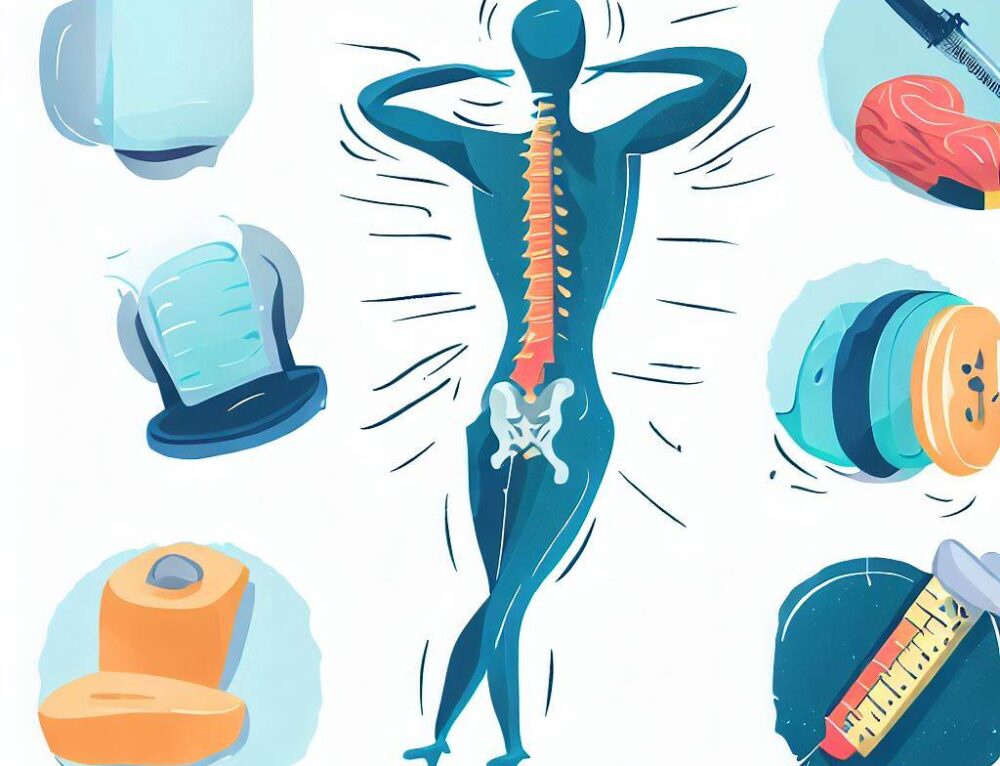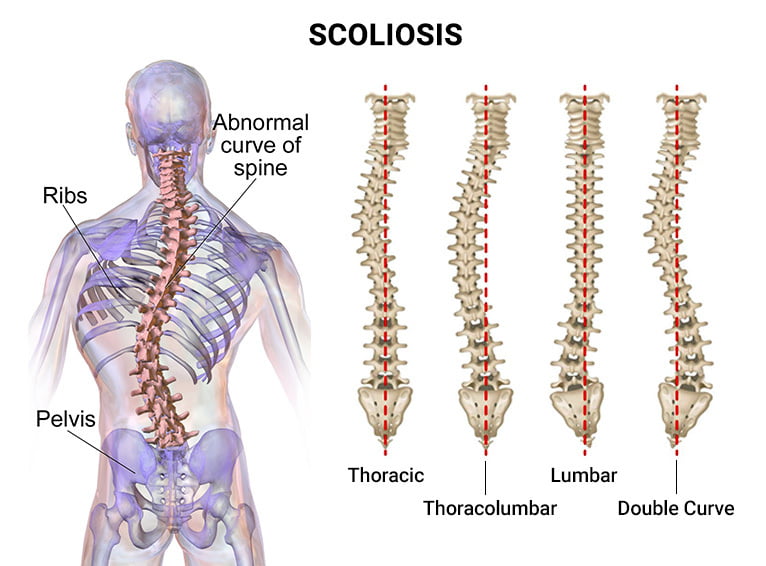Scoliosis is a medical condition characterized by an abnormal curvature of the spine. It affects approximately 2-3% of the population, with the majority of cases occurring in adolescents during their growth spurt. While scoliosis primarily affects the musculoskeletal system, it can also have a significant impact on lung function, leading to a condition known as restrictive lung disease.
Restrictive lung disease refers to a group of disorders that restrict the expansion of the lungs, making it difficult for individuals to breathe properly. Scoliosis can contribute to the development of restrictive lung disease by affecting the shape and function of the chest cavity, as well as the respiratory muscles. Understanding the relationship between scoliosis and lung function is crucial for early detection and intervention, as it can help prevent further complications and improve the quality of life for affected individuals.

Understanding Scoliosis: Causes, Symptoms, and Types
Scoliosis can have various causes, including congenital abnormalities, neuromuscular conditions, and idiopathic factors. Idiopathic scoliosis, which accounts for approximately 80% of cases, has no known cause and typically develops during adolescence. It is more common in females and tends to progress rapidly during periods of growth.
The symptoms of scoliosis can vary depending on the severity of the curvature. Mild cases may only cause cosmetic concerns, while more severe cases can lead to pain, difficulty breathing, and reduced physical function. Common signs of scoliosis include an uneven waistline, one shoulder higher than the other, and an asymmetrical ribcage.
There are different types of scoliosis, including adolescent idiopathic scoliosis, congenital scoliosis, neuromuscular scoliosis, and degenerative scoliosis. Each type has its own unique characteristics and underlying causes, but they all share the potential to impact lung function and contribute to restrictive lung disease.

Overview of Restrictive Lung Disease: Definition and Types
Restrictive lung disease is a broad term used to describe a group of disorders that limit the expansion of the lungs, resulting in decreased lung capacity and impaired breathing. It can be caused by various factors, including lung tissue scarring, chest wall deformities, and muscle weakness.
There are several types of restrictive lung disease, including interstitial lung disease, chest wall disorders, and neuromuscular diseases. Interstitial lung disease involves inflammation and scarring of the lung tissue, leading to reduced lung function. Chest wall disorders, such as scoliosis, can restrict lung expansion by altering the shape and mechanics of the chest cavity. Neuromuscular diseases, such as muscular dystrophy, can weaken the respiratory muscles, making it difficult for individuals to breathe effectively.
The Relationship Between Scoliosis and Lung Function
Scoliosis can have a significant impact on lung function due to the changes it causes in the shape and mechanics of the chest cavity. As the spine curves abnormally, it can compress the lungs and reduce their capacity to expand fully. This compression can lead to decreased lung volumes, impaired gas exchange, and reduced oxygen levels in the blood.
In addition to the physical compression of the lungs, scoliosis can also affect the position and function of the respiratory muscles. The abnormal curvature of the spine can cause the ribcage to twist, leading to imbalances in the muscles that support breathing. This can result in weakened respiratory muscles, making it harder for individuals with scoliosis to take deep breaths and effectively exhale.

How Scoliosis Can Affect Lung Capacity
One of the key ways scoliosis impacts lung function is by reducing lung capacity. Lung capacity refers to the maximum amount of air that can be inhaled or exhaled during a breath. In individuals with scoliosis, the abnormal curvature of the spine can restrict the expansion of the lungs, leading to a decrease in lung capacity.
Studies have shown that individuals with scoliosis often have reduced lung volumes compared to those without the condition. Specifically, the vital capacity, which is the maximum amount of air that can be exhaled after a maximum inhalation, is often lower in individuals with scoliosis. This reduction in lung capacity can result in shortness of breath, fatigue, and decreased exercise tolerance.
Impact of Scoliosis on Respiratory Muscles
Scoliosis can also have a significant impact on the respiratory muscles, which play a crucial role in breathing. The abnormal curvature of the spine can cause imbalances in the muscles that support respiration, leading to weakness and reduced efficiency in breathing.
The diaphragm, a dome-shaped muscle located at the base of the lungs, is the primary muscle responsible for inhalation. In individuals with scoliosis, the abnormal curvature of the spine can cause the diaphragm to be positioned at a mechanical disadvantage, reducing its ability to contract fully. This can result in shallow breathing and decreased lung expansion.
Additionally, the intercostal muscles, which are located between the ribs and assist in breathing, can also be affected by scoliosis. The twisting of the ribcage can lead to imbalances in these muscles, causing weakness and reduced effectiveness in breathing. This can further contribute to decreased lung capacity and impaired respiratory function.
Scoliosis and Lung Mechanics: Changes in Breathing Patterns
Scoliosis can also lead to changes in breathing patterns, further impacting lung function. As the spine curves abnormally, it can cause the ribcage to twist and become asymmetrical. This asymmetry can result in imbalances in the muscles involved in breathing, leading to altered breathing patterns.
Individuals with scoliosis often exhibit paradoxical breathing, where the chest and abdomen move in opposite directions during breathing. This abnormal breathing pattern can reduce the efficiency of breathing and lead to decreased lung volumes. It can also result in increased work of breathing, as the respiratory muscles have to work harder to overcome the mechanical limitations imposed by the abnormal curvature of the spine.
Complications of Scoliosis Leading to Restrictive Lung Disease
If left untreated, scoliosis can lead to the development of restrictive lung disease. The compression of the lungs and the alterations in respiratory muscle function can result in decreased lung volumes, impaired gas exchange, and reduced oxygen levels in the blood. Over time, these changes can lead to respiratory symptoms, such as shortness of breath, fatigue, and decreased exercise tolerance.
In severe cases of scoliosis, the compression of the lungs can also lead to the development of pulmonary hypertension, a condition characterized by increased pressure in the blood vessels of the lungs. Pulmonary hypertension can further impair lung function and lead to complications such as heart failure and respiratory failure.
Diagnosing Scoliosis-Related Lung Function Impairment
Diagnosing lung function impairment in individuals with scoliosis requires a comprehensive evaluation that includes both clinical assessment and objective testing. The clinical assessment involves a thorough medical history, physical examination, and evaluation of respiratory symptoms. It is important for healthcare professionals to be aware of the potential impact of scoliosis on lung function and to ask specific questions related to breathing difficulties.
Objective testing, such as pulmonary function tests (PFTs), can provide valuable information about lung volumes, airflow, and gas exchange. PFTs involve breathing into a machine that measures various parameters, including forced vital capacity (FVC), forced expiratory volume in one second (FEV1), and diffusing capacity for carbon monoxide (DLCO). These tests can help determine the severity of lung function impairment and guide treatment decisions.
In some cases, additional imaging studies, such as chest X-rays or CT scans, may be necessary to assess the extent of lung compression and identify any underlying lung pathology. These imaging studies can provide valuable information about the structural changes in the chest cavity and help guide treatment planning.
Treatment Approaches for Scoliosis and Restrictive Lung Disease
The treatment of scoliosis-related lung function impairment involves a multidisciplinary approach that addresses both the spinal deformity and the associated respiratory symptoms. The primary goal of treatment is to prevent further progression of the spinal curvature, improve lung function, and enhance the overall quality of life for affected individuals.
In mild cases of scoliosis, conservative treatment options may be sufficient. These can include regular monitoring, physical therapy, and bracing. Physical therapy can help strengthen the respiratory muscles and improve breathing mechanics, while bracing can help prevent further progression of the spinal curvature.
In more severe cases of scoliosis, surgical intervention may be necessary. Spinal fusion surgery is the most common surgical procedure used to correct the spinal curvature and stabilize the spine. By straightening the spine, this surgery can alleviate the compression of the lungs and improve lung function. However, it is important to note that surgery may not always completely restore lung function, especially in cases where there has been significant damage to the lungs.
Managing Lung Function in Scoliosis Patients
In addition to treating the underlying spinal deformity, it is important to manage lung function in individuals with scoliosis. This can involve various strategies aimed at improving breathing mechanics, enhancing lung capacity, and preventing further respiratory complications.
Physical therapy plays a crucial role in managing lung function in scoliosis patients. It can help strengthen the respiratory muscles, improve breathing mechanics, and increase lung capacity. Breathing exercises, such as deep breathing and diaphragmatic breathing, can also be beneficial in improving lung function and promoting efficient breathing.
Regular exercise is another important aspect of managing lung function in scoliosis patients. Engaging in physical activity can help improve cardiovascular fitness, increase lung capacity, and enhance overall respiratory function. It is important for individuals with scoliosis to work with a healthcare professional to develop an exercise program that is safe and tailored to their specific needs.
In some cases, supplemental oxygen therapy may be necessary to improve oxygen levels in the blood and alleviate respiratory symptoms. This can be particularly beneficial for individuals with severe scoliosis and significant lung function impairment. Oxygen therapy can help improve exercise tolerance, reduce shortness of breath, and enhance overall quality of life.
Conclusion: Importance of Early Detection and Intervention
Scoliosis can have a significant impact on lung function, leading to the development of restrictive lung disease. The abnormal curvature of the spine can compress the lungs, alter respiratory muscle function, and result in decreased lung volumes and impaired gas exchange. If left untreated, scoliosis-related lung function impairment can lead to respiratory symptoms, decreased exercise tolerance, and complications such as pulmonary hypertension.
Early detection and intervention are crucial in managing scoliosis-related lung function impairment. Regular monitoring, physical therapy, and bracing can help prevent further progression of the spinal curvature and improve lung function in mild cases. In more severe cases, surgical intervention may be necessary to correct the spinal deformity and alleviate lung compression.
Managing lung function in individuals with scoliosis involves a multidisciplinary approach that includes physical therapy, breathing exercises, regular exercise, and, in some cases, supplemental oxygen therapy. By addressing both the spinal deformity and the associated respiratory symptoms, healthcare professionals can help improve lung function and enhance the overall quality of life for individuals with scoliosis.
Referenzen
- Weinstein SL, Dolan LA, Cheng JC, et al. "Adoleszente idiopathische Skoliose". Lancet. 2008;371(9623):1527-1537. doi: 10.1016/S0140-6736(08)60658-3.
- Negrini S, Donzelli S, Aulisa AG, et al. "2016 SOSORT guidelines: Orthopädische und rehabilitative Behandlung der idiopathischen Skoliose während des Wachstums." Skoliose und Wirbelsäulenbeschwerden. 2018;13:3. doi: 10.1186/s13013-018-0175-8.
- Trobisch P, Suess O, Schwab F. "Idiopathische Skoliose". Dtsch Arztebl Int. 2010;107(49):875-883. doi: 10.3238/arztebl.2010.0875.
- Hresko MT. "Klinische Praxis. Idiopathische Skoliose bei Heranwachsenden". N Engl J Med. 2013;368(9):834-841. doi: 10.1056/NEJMcp1209063.
- Bettany-Saltikov J, Weiss HR, Chockalingam N, et al. "Chirurgische versus nicht-chirurgische Interventionen bei Menschen mit jugendlicher idiopathischer Skoliose". Cochrane Datenbank Syst Rev. 2015;2015(4). doi: 10.1002/14651858.CD010663.pub2.
- Sozialversicherungsanstalt. "Invaliditätsleistungen". https://www.ssa.gov/benefits/disability/.
- Lonstein JE, Carlson JM. "Die Vorhersage der Kurvenprogression bei unbehandelter idiopathischer Skoliose während des Wachstums". J Bone Joint Surg Am. 1984;66(7):1061-1071. doi: 10.2106/00004623-198466070-00008.
- Kaspiris A, Grivas TB, Weiss HR, Turnbull D. "Skoliosis: Review of diagnosis and treatment". Internationale Zeitschrift für Orthopädie. 2013;37(1):34-42. doi: 10.1038/s41390-020-1047-9.

